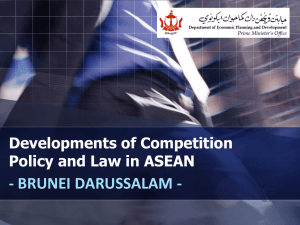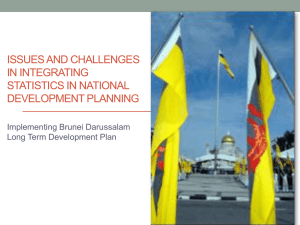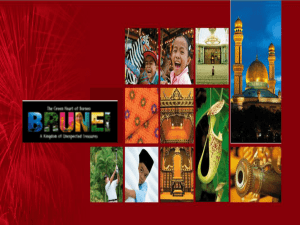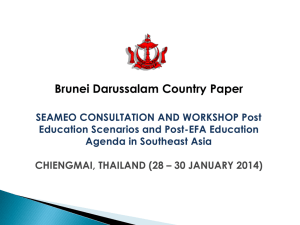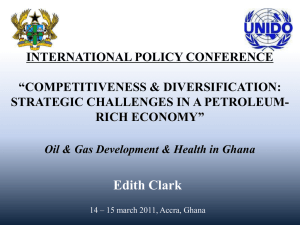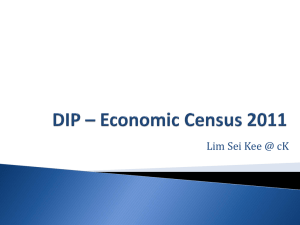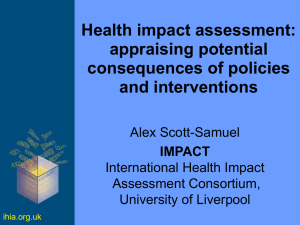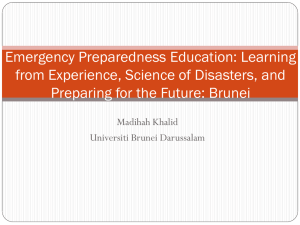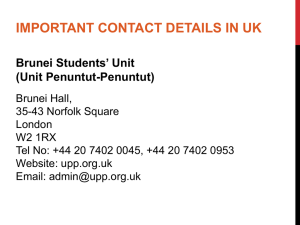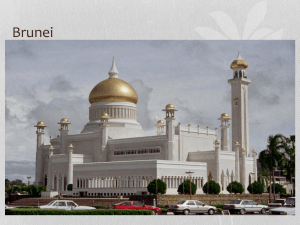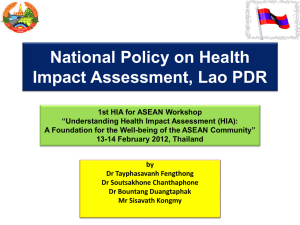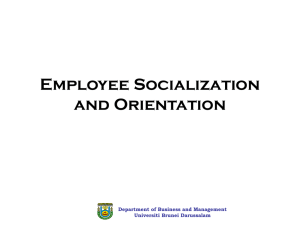Brunei Darussalam Country Report
advertisement
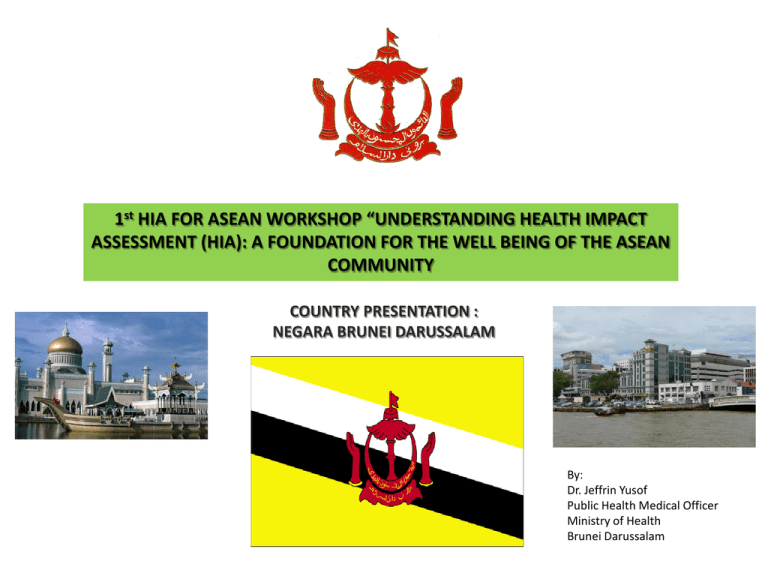
1st HIA FOR ASEAN WORKSHOP “UNDERSTANDING HEALTH IMPACT ASSESSMENT (HIA): A FOUNDATION FOR THE WELL BEING OF THE ASEAN COMMUNITY COUNTRY PRESENTATION : NEGARA BRUNEI DARUSSALAM By: Dr. Jeffrin Yusof Public Health Medical Officer Ministry of Health Brunei Darussalam Presentation Outline 1. Brief overview on Brunei Darussalam 2. Health Status in Brunei Darussalam 3. Why we should have HIA in Brunei Darussalam 4. HIA development in Brunei Darussalam 5. Recommendations for promoting HIA in Brunei Darussalam and ASEAN 6. Challenges in Brunei Darussalam BRUNEI DARUSSALAM COUNTRY PROFILE • • • • • Capital : Bandar Seri Begawan Total area : 5,765 sq km Total population : 414,400 (2010) Ethnic group : Malay, Chinese, Indigenous and others Government type : Sultanate constitution (known as Malay Islamic Monarchy) • Import : Machinery and Transport Equipments, Manufactured goods, Foods and Chemicals • Export : Crude Oil, Natural Gas • Natural resources : Oil and Gas BRUNEI DARUSSALAM PROFILE • Four districts:1. Brunei-Muara 2. Belait 3. Tutong 4. Temburong • Terrain: To the East - flat coastal plain rises to mountains; to the West - hilly lowland with a few mountain ridges. • Climate: Equatorial; high temperatures and high humidity, and rainfall. • Languages: Malay, English, Chinese, Iban and other indigenous dialects HEALTH STATUS IN BRUNEI DARUSSALAM • The four leading causes of death which accounted for 50% of the total deaths are Cancer (malignant neoplasms), Heart Diseases, Diabetes mellitus and Cerebrovascular Diseases (2010) • All Brunei citizens have access to free healthcare from public hospitals WHY WE SHOULD HAVE HIA IN BRUNEI DARUSSALAM WHY WE SHOULD HAVE HIA IN BRUNEI DARUSSALAM As part of our National Health Care Plan Strategic Goals:• • • • • • • Enhance the quality of health care Improve the quality of policy-making and management Enhance cost-effectiveness in Health Service Delivery Seek innovative ways for health care financing and funding Promotion of cultural changes in the work place Enhancing technology and information management Strengthening the management of the emergence of chronic non communicable diseases • Prevention of the re-emergence of ‘old’ communicable diseases In terms of environmental policy:• • • To maintain sustainable utilization of natural resources To minimize negative impacts on environment arising from population growth and human activities To achieve balanced goals of socio-economic development and sound environmental quality HIA DEVELOPMENT IN BRUNEI DARUSSALAM In Brunei Darussalam, relevant departments and agencies have developed guidelines, standards and regulations to protect the environment. The recent development of the Environment Order by the Department of Environment, Parks and Recreation has brought all relevant acts and regulations under one umbrella to address the environmental issues. Some of the relevant acts / guidelines adopted are listed as follows:• Poison Act: This legislation extends provision to control the import, sale, storage, handling and use of hazardous chemicals. All chemicals, which are classified under the scheduled list, are subjected to legislative control by this act. The control of these chemicals are governed by the issuance of licence to import and store, to keep and sell by wholesale or retail. • Land transport Act: This led to the establishment of vehicle inspection centres and accreditation of workshops. The act also looks into the emissions generated from vehicles. • Standard for Industrial Effluents: The guideline outlines the accepted standards to be observed by all industries and other sources which discharge the effluents directly into sewage treatment plants and waterways HIA DEVELOPMENT IN BRUNEI DARUSSALAM • Municipal Act and the Miscellaneous Licenses Act: Controls all business activities and issuances of licences • Infectious Disease Act: Controls and prevents infectious diseases in Brunei Darussalam and prevents the entry of such diseases through the various movements of population. EHD/201 HIA DEVELOPMENT IN BRUNEI DARUSSALAM • Public Health (Food) Act, 2000: Controls the quality and safety of imported and locally produced food products, and assessment of food premises and food handlers. • Public Health Emergency Operation Plan: Primarily to guide Public Health Personnel in planning, mitigating and responding to a public health emergency in Brunei Darussalam according to current best practices and taking into consideration the constraints within the Department of Health Services. • Building Guidelines and Requirements, Brunei Darussalam Standard: Subject to periodical review to the current needs of the local industries to keep abreast of progress in the industries concerned, for example, health requirements for building industrial premises. RECOMMENDATIONS FOR PROMOTING HIA BRUNEI DARUSSALAM AND ASEAN BRUNEI • Identification of stakeholders involved in HIA and proper governance of HIA by stakeholders and thus having consistency between multi-sectoral stakeholders in the application of HIA • Identification and clarification of activities of HIA and EIA is required whether it needs to be separated or integrated as this involves different Ministries, namely the Ministry of Health and Ministry of Development, respectively, in order to prevent duplication . • Requirement of epidemiological studies, reviews, mapping and development of methodological processes for HIA • Capacity building and training further required in the application of HIA RECOMMENDATIONS FOR PROMOTING HIA IN BRUNEI DARUSSALAM AND ASEAN BRUNEI • Existing policies and guidelines may need to be reviewed to determine whether HIA is necessary and every HIA in place should be reviewed and updated if necessary through S.W.O.T analysis (Strength, Weaknesses, Opportunity, Threats) • Surveillance and monitoring programmes should be established and enhanced to gather evidence based data and information, as a reference in decision making. • Widespread public awareness on the importance of HIA is necessary • Enhancing community participation in prevention and health promotion programmes. RECOMMENDATIONS FOR PROMOTING HIA IN YOUR COUNTRY AND ASEAN ASEAN LEVEL Sharing and support amongst ASEAN member states and relevant international organisations in the areas of : Capacity building Expertise Information sharing Experience Advisory Technology CHALLENGES IN BRUNEI DARUSSALAM • Further expertise and manpower • Training and capacity building • Evidence based practices and research • Understanding of HIA amongst high level multi-sectoral stakeholders • Funding and resources • Public awareness and participation THANK YOU
